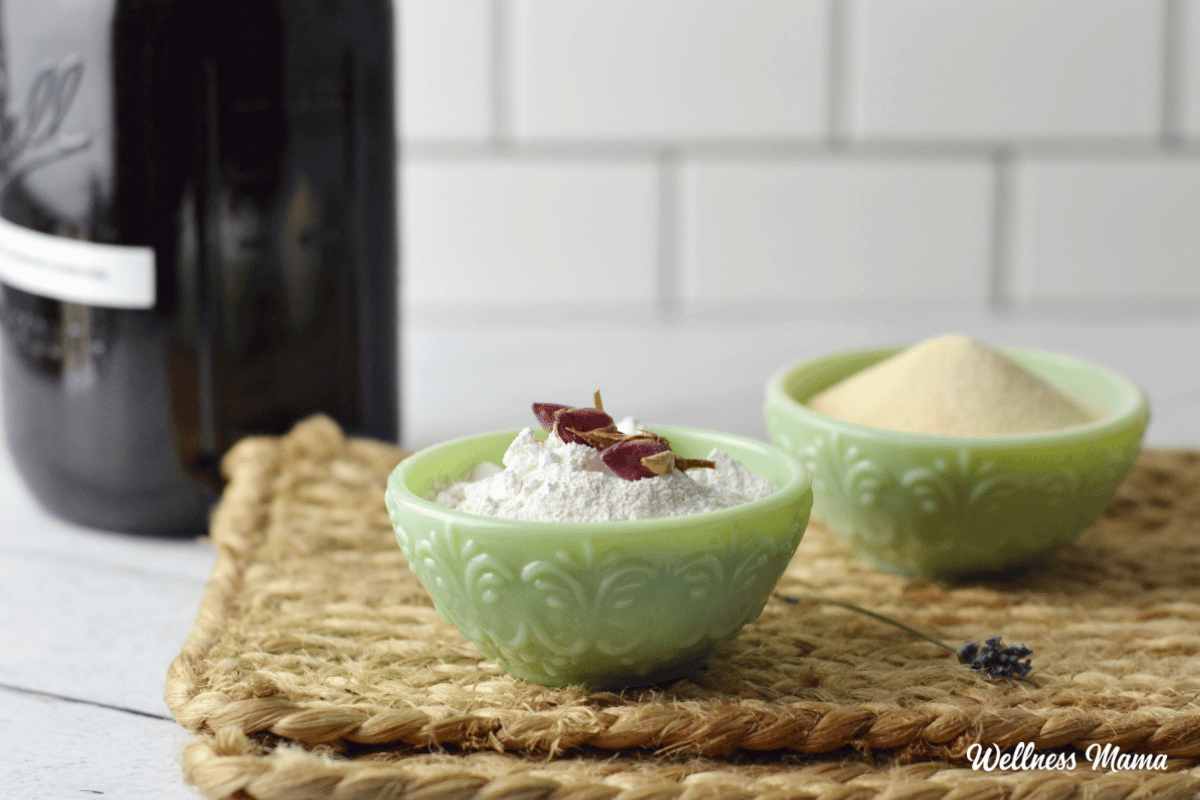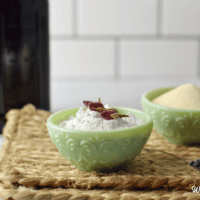I love a good face mask. Not only can they be good for your skin, but it’s also a good way to get a little self care in. These peel-off face mask recipes with gelatin are exfoliating, moisturizing, and a great addition to your skincare routine!
What are Peel-Off Face Masks?
In the past, I’ve made face masks with everything from aloe to turmeric. The thick pastes spread easily onto skin to help with brightening, dry skin, and even fine lines. Peel-off masks are a little different because they dry into a semi-tacky sheet that peels off of the skin.
Popular active ingredients in store bought peel-off masks include polyvinyl alcohol and polyvinyl acetate (glue). These help the mask form a film on skin. Some DIY mask recipes call for mixing Elmer’s glue into the formula. No thank you!
They’re similar to sheet masks in that the product sits on the skin for a while. However, sheet masks are cloth or plastic saturated with skincare ingredients. Peel-off masks start out as a liquid and then harden before removal.
Are Peel-Off Masks Good For Your Skin?
If they’re made of glue, harsh chemicals, dyes, and other sketchy ingredients, then no. Some peel-off facial masks are also harder to remove and not good for sensitive skin. These skincare products can cause redness, irritation, itching, and other skin damage. And while ingredients like glycolic and salicylic acid may reduce dark spots, they can also be very irritating.
Masks with nourishing ingredients that don’t stick like glue to skin (literally!) can be beneficial though. The idea is to get something that easily pulls off, without damaging skin.
Peel-Off Face Mask Benefits
As long as you have a good face mask, they can be great for many skin types. Changing up the ingredients can help with acne-prone skin, detoxifying, or even anti-aging. Here are some more benefits of peel-off masks:
- May unclog pores and remove impurities
- Helps nourish and detox to diminish blemishes
- Removes excess oil for oily skin
- Gets rid of dead skin cells
- Deep cleansing so skin feels fresh
- Purifying for better skin tone
- Helps remove fine hairs and “peach fuzz”
Don’t Want to Make It?
If you’re not in the mood to DIY or don’t have the ingredients, then there are some good premade peel-off masks. Most of them use polyvinyl acetate or alcohol, but some use alginate from seaweed. Here’s a purifying mask to buy that uses alginate and other skin nourishing ingredients.
Ingredients in Gelatin Masks
We’ve already covered some ingredients to skip, but what about healthy ingredients for your skin? The great thing about homemade masks is that you can customize them however you want! I use gelatin to get the mask to stick and then peel it from the skin. It’s full of collagen to help skin bounce back and reduce fine lines and wrinkles.
You’ll also need a liquid of some kind and optionally powders or essential oils.
You can add hyaluronic acid to help draw moisture to the skin, firm, and improve elasticity. Antioxidants, like vitamin C, green tea, and pomegranate help protect against free radical damage. Mix the gelatin with herbal teas for added health benefits. Or use witch hazel to act as an astringent or for acne-prone skin. Make a clay peel-off face mask with bentonite clay to detox.
To recap you’ll use:
- Gelatin
- Liquid (witch hazel, glycerin, honey, milk, herbal tea, etc.)
- Powders and essential oils (optional)
There are so many options, but I’ve included some recipes below to get you started.
Do Peel-Off Masks Remove Blackheads?
A lot of websites tout their peel-off face masks as a blackhead remover. Some sources say they can help with blackheads, while others say no. Peel-off masks remove the top layer of dead skin cells, but they may not reach deeply enough into pores to remove blackheads. By keeping the skin clean and nourished though it’s less likely to develop blackheads in the future. So the answer is no… and yes.
Safety Cautions + Tips
Those with eczema, psoriasis, rosacea, sunburn, and other damaged skin should skip peel-off masks. The pulling can further damage very sensitive skin. Some safer options are soothing masks with raw honey or hydrosols.
If the mask is too hard to peel off the skin and is painful, then just wash it off with warm water instead. I’ve tried to strike the right balance of gelatin in the recipes below so it’s sticky, but not too sticky. The thicker you put the gelatin on your skin, the stronger its pull is.
Since peel-off face masks deeply exfoliate it’s best to use them no more than once a week. It’s also key to choose the right ingredients for your skin type. If you have dry skin, then ingredients like kaolin clay and charcoal can dry it out more.
DIY Peel-Off Face Masks (With Gelatin)
Materials
Brightening Charcoal Peel-Off Mask
- ½ TBSP gelatin powder (not collagen)
- 1 TBSP witch hazel (or cool water)
- ⅛ tsp activated charcoal powder
- 1-2 drops orange essential oil (optional)
Soothing Clay Mask
- ½ TBSP gelatin powder
- ½ tsp raw honey (or glycerin)
- 1 TBSP coconut milk (or raw, grass-fed milk)
- ½ tsp kaolin clay
- 1-2 drops lavender essential oil (optional)
Instructions
- Add the liquid ingredients to a small bowl.
- Evenly sprinkle the gelatin over the liquid and allow it to bloom, about 1 minute.
- Scrape the gelatin mixture into a small saucepan. Gently heat the on the stove over low heat, stirring constantly, just until melted and combined.
- Stir in the powder ingredients and essential oils.
- Apply an even coating of the warm (not hot!) mask to the face with your fingers. Avoid the undereye area, eyebrows, eyes, and hairline.
- Leave on for about 15 minutes, or until completely dry.
- Gently peel off the mask. Wash off any excess with warm water.
Notes
- You can use a gentle cleanser before using the mask. Don’t use one after to avoid skin irritation.
- Follow up your mask with a serum or moisturizer if desired.
More Face Mask Recipes
If you want to try a face mask, but aren’t into peeling one off of your face, here are more options:
- Probiotic Face Mask
- Chocolate Face Mask Recipe
- Hydrating Pumpkin Spice Face Mask
- Homemade Honey Face Mask
- Brightening Turmeric Face Mask
- Matcha Green Tea Face Mask
Have you ever used a peel-off face mask before? What ingredients will you use? Leave a comment and let me know!



Leave a Reply